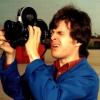-
Posts
3,856 -
Joined
-
Last visited
Everything posted by Mark Dunn
-

Potential dilemma to cropping regular 16mm to widescreen aspect ratios
Mark Dunn replied to Patrick Cooper's topic in 16mm
I tend to agree with Simon. With digital cinema AR is less and less relevant. You'll see documentaries with the archive left at 4:3. Much better that fake widescreen barbarously cropped. But it does suggest a period look nowadays. I think "Wycliffe" (1995-ish) was the first UK drama to be shot in 16:9, protected I think for the intermediate 14:9. If you can get to see some episodes it's an interesting study in how cinematographic grammar was changing to accommodate widescreen TV- sizes of closeups, etc. plus it's got Jack Shepherd in it. -
Since my phone light isn't working (the app still works) I've been using a torch- it seems to focus when there's plenty of light.
-
Brilliant, thanks. The camera doesn't seem to focus but I can see I have the Steenbeck running about 1% slow. Good enough.
-
Right. I want that for the Steenbeck.!
-
Well if the motor's working well, you probably don't want to take it to bits to see what's going on. We're both curious, right? But not daft. What size is the jack BTW? Just, er, curious.
-

I bought a used equipment case. It is very old.
Mark Dunn replied to Phil Rhodes's topic in General Discussion
Have you decided the orientation question? As you have it there or side-opening, handle on top, feet on the ground? -
Because they can? Same way you have to pay extra to make Arris do certain things. Even happens in cars now- the facility is in the vehicle as manufactures but you have to pay extra to turn it on. BMW do it with heated seats- you rent them by the month. There's some justification if the higher res scans take longer and produce more data, though.
-
He can answer for himself but I found Resolve very resource-intensive on an older machine, which is what Daniel seems to have. Translation: it didn't work. But I don''t think either of us is in the facilities house league. Lightworks, however, is much easier to run. But this may not be at the data rate needed for scans. My DSLR's HD is only 25MBps.
-

Some questions for an experiment on Arriflex SR2
Mark Dunn replied to brandon kaufman's topic in 16mm
Increase, surely. -
Quite right. I don't know the dimensions, does 3.5mm seem right?
-
Well, crystal sync obviates the need for a pilotone signal, I think, (as I recall pilotone plugs were multi-pin) and the manual makes no mention of either the socket or any function which might use it. So maybe your 'scope will tell us something.
-
Yes. Neutral is the motor case itself. Hence the insulating cap. I don't know what the jack is for either. There doesn't seem to be room on the back of the camera for anything to plug into it.
-
I know, but you've put them up before and they're so classy- perhaps the "home movie" thing should stay between us, wink wink.
-
I can't wait to see 'Scope ratio home movies in 35mm.
-
Seems to be very expensive in the UK- £46 for a small can and 2 months back order. I don't think there's any suggestion that these screws are seized or rusty, which is why I suggested WD or machine oil rather than penetrating oil. In fact if I had neither I'd use a drop of cooking oil, assuming the screws are actually stuck. They may be fine.
- 12 replies
-
- 16mm
- arriflex st
-
(and 2 more)
Tagged with:
-
I don't think the mixing idea will work as you're combining reflective and transmissive colours. You would just get a yellow/red tinted blue. Just make sure that the white spot is bright enough to read as white on the background.
-
Not that fast but quite possibly 20 or 22. I wish I could remember the reference. That's a studio setup so the light sources are all phoney- the light from the flashgun isn't the bulb going off, it's a studio light reflecting in it- but it wasn't unusual for the flash not to be synchronised to the shutter at all. You set the shutter to B or T, opened, fired the flash, then closed. The dark slide was to prevent any stray light getting in. You'd lift it just for the flash. Typically you'd hold it much closer to the lens, obviously without touching it to avoid vibration. The technique is called "open flash". I was using it until recently in the studio- for some reason my DSLR wouldn't trigger my 1980s-era studio flashes using the usual lead. Something to do with resistance, according to the manufacturer of the flash. Getting a wireless release solved the problem, so now I don't have to draw the curtains. Edit: just noticed- see the two plugs hanging free between the camera body and the cable-release gizmo (which may be a clockwork timer)? I think they're the flash leads- the flat cable looks the same. It's not plugged in to the lens at all. I've even used the dark slide as a shutter to time a long exposure. 1-2-3-4-5 etc.



